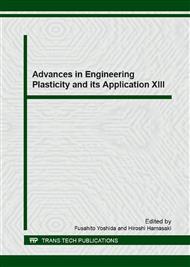p.132
p.138
p.143
p.149
p.156
p.162
p.168
p.177
p.183
Numerical Study of the Effects of Strain Rate and Cell Geometry on Dynamic Behavior of Axial Crushing Honeycomb
Abstract:
The axial crushing behavior of commercial metal honeycombs was studied with laying emphasis on the effects of strain rate and geometry on its characteristics as an energy absorber. To investigate the effect of strain rate on the energy absorption capacity, the honeycombs of some metal foil materials were numerically modeled by taking the plastic deformation and failure of adhesively-bonded joint between corrugated sheets and the initial imperfection into consideration. The relationship between the enhancement of mean buckling stress and the strain rate was discussed. Furthermore, A3003 honeycomb model was examined by changing its branch angle from 30° to 180° because the geometrical dispersion will also affect the energy absorption capacity. Typical calculated results under different strain rate and geometric conditions were compared with the corresponding experimental results. It was found that the effect of strain rate on the stress – strain relation of the honeycomb structure is greatly relaxed as compared with that of the material itself. The effects of the boundary condition on the crushing behavior of irregular honeycombs were also discussed.
Info:
Periodical:
Pages:
156-161
Citation:
Online since:
December 2016
Authors:
Price:
Сopyright:
© 2017 Trans Tech Publications Ltd. All Rights Reserved
Share:
Citation:


